KitchenAid KECD867XSS00, KECD807XSS00, KECD867XBL00, KECD807XBL00, W10296511A User Manual
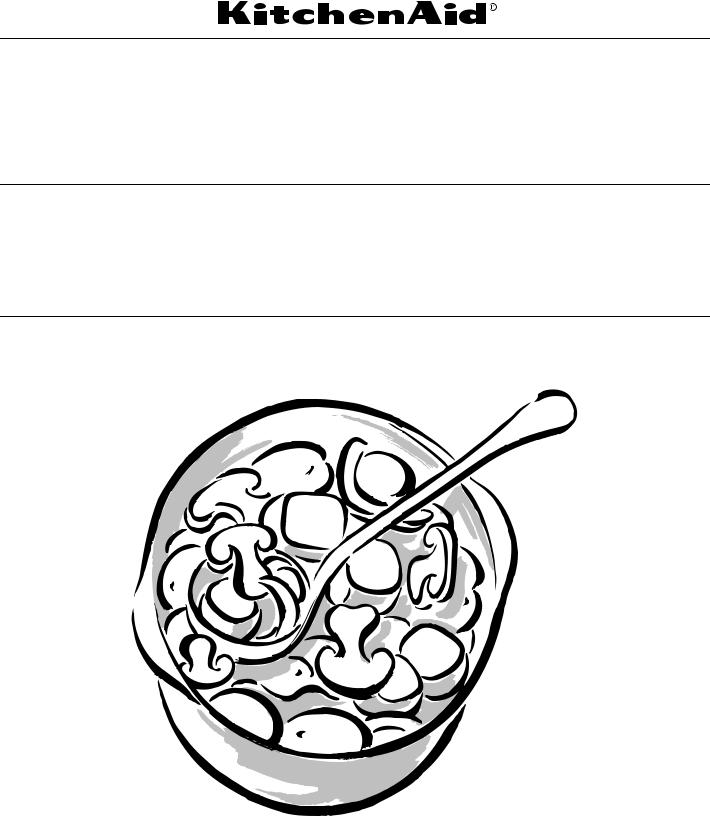
30” AND 36” (76.2 CM AND 91.4 CM) DOWNDRAFT RADIANT COOKTOP
Use&CareGuide
For questions about features, operation/performance, parts, accessories or service, call: 1-800-422-1230 or visit our website at www.kitchenaid.com
In Canada, call 1-800-807-6777 or visit our website at www.KitchenAid.ca
TABLE DE CUISSON RADIANTE À EXTRACTION PAR LE BAS DE 30" ET 36" (76,2 CM ET 91,4 CM)
Guided’utilisationetd’entretien
Au Canada, pour assistance, installation ou service, composer le 1-800-807-6777 ou visiter notre site Web au www.KitchenAid.ca
Table of Contents/Table des matières ............................................................................ |
2 |
Models/Modèles KECD807XBL00, KECD807XSS00, KECD867XBL00, KECD867XSS00
W10296511A
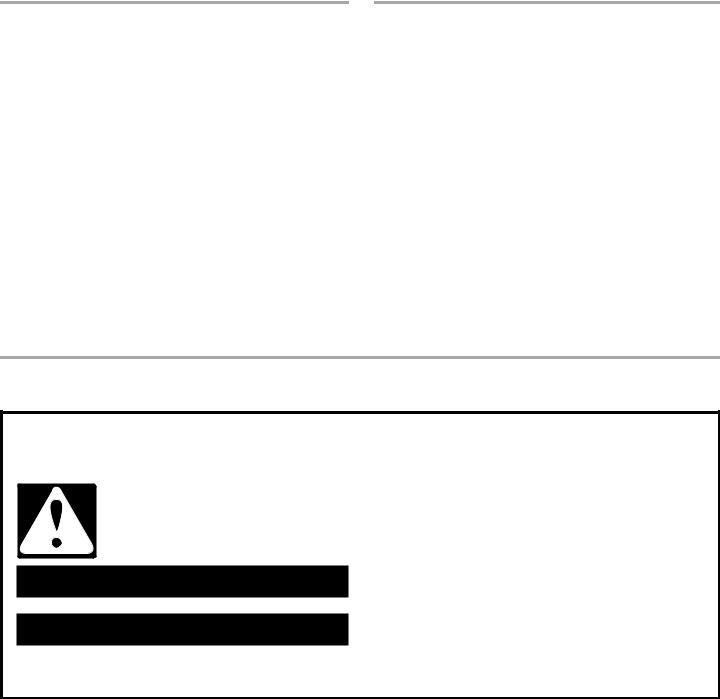
TABLE OF CONTENTS |
|
COOKTOP SAFETY........................................................................ |
2 |
PARTS AND FEATURES................................................................ |
4 |
COOKTOP USE .............................................................................. |
5 |
Cooktop Controls......................................................................... |
5 |
Dual-Circuit Element .................................................................... |
5 |
Warm Zone Element .................................................................... |
6 |
Melt............................................................................................... |
6 |
Ceramic Glass.............................................................................. |
6 |
Downdraft Ventilation System ..................................................... |
7 |
Home Canning ............................................................................. |
7 |
Cookware ..................................................................................... |
7 |
COOKTOP CARE............................................................................ |
8 |
General Cleaning.......................................................................... |
8 |
TROUBLESHOOTING .................................................................... |
9 |
ASSISTANCE OR SERVICE......................................................... |
10 |
In the U.S.A. ............................................................................... |
10 |
Accessories ................................................................................ |
10 |
In Canada ................................................................................... |
10 |
WARRANTY .................................................................................. |
11 |
TABLE DES MATIÈRES |
|
SÉCURITÉ DE LA TABLE DE CUISSON .................................... |
12 |
PIÈCES ET CARACTÉRISTIQUES .............................................. |
14 |
UTILISATION DE LA TABLE DE CUISSON................................ |
16 |
Commandes de la table de cuisson .......................................... |
16 |
Élément à double circuit............................................................. |
16 |
Élément Warm Zone (zone de maintien au chaud).................... |
17 |
Melt (faire fondre) ....................................................................... |
17 |
Vitrocéramique ........................................................................... |
17 |
Système de ventilation avec aspiration par le bas .................... |
18 |
Préparation de conserves à la maison....................................... |
18 |
Ustensiles de cuisson ................................................................ |
18 |
ENTRETIEN DE LA TABLE DE CUISSON .................................. |
19 |
Nettoyage général ...................................................................... |
19 |
DÉPANNAGE................................................................................. |
20 |
ASSISTANCE OU SERVICE......................................................... |
21 |
Aux États-Unis............................................................................ |
21 |
Accessoires ................................................................................ |
21 |
Au Canada.................................................................................. |
21 |
GARANTIE..................................................................................... |
22 |
COOKTOP SAFETY
Your safety and the safety of others are very important.
We have provided many important safety messages in this manual and on your appliance. Always read and obey all safety messages.
This is the safety alert symbol.
This symbol alerts you to potential hazards that can kill or hurt you and others.
All safety messages will follow the safety alert symbol and either the word “DANGER” or “WARNING.” These words mean:
 DANGER
DANGER
 WARNING
WARNING
You can be killed or seriously injured if you don't immediately follow instructions.
You can be killed or seriously injured if you don't follow instructions.
All safety messages will tell you what the potential hazard is, tell you how to reduce the chance of injury, and tell you what can happen if the instructions are not followed.
2

IMPORTANT SAFETY INSTRUCTIONS
WARNING: To reduce the risk of fire, electrical shock, injury to persons, or damage when using the cooktop, follow basic precautions, including the following:
■ CAUTION: Do not store items of interest to children in cabinets above a cooktop – Children climbing on the cooktop to reach items could be seriously injured.
■Proper Installation – Be sure your cooktop is properly installed and grounded by a qualified technician.
■Never Use Your Cooktop for Warming or Heating the Room.
■Do Not Leave Children Alone – Children should not be left alone or unattended in area where cooktop is in use. They should never be allowed to sit or stand on any part of the cooktop.
■Wear Proper Apparel – Loose-fitting or hanging garments should never be worn while using the cooktop.
■User Servicing – Do not repair or replace any part of the cooktop unless specifically recommended in the manual. All other servicing should be referred to a qualified technician.
■Storage on Cooktop – Flammable materials should not be stored near surface units.
■Do Not Use Water on Grease Fires – Smother fire or flame or use dry chemical or foam-type extinguisher.
■Use Only Dry Potholders – Moist or damp potholders on hot surfaces may result in burns from steam. Do not let potholder touch hot heating elements. Do not use a towel or other bulky cloth.
■DO NOT TOUCH SURFACE UNITS OR AREAS NEAR UNITS – Surface units may be hot even though they are dark in color. Areas near surface units may become hot enough to cause burns. During and after use, do not touch, or let clothing or other flammable materials contact surface units or areas near units until they have had sufficient time to cool. Among those areas are the cooktop and surfaces facing the cooktop.
■Use Proper Pan Size – This cooktop is equipped with one or more surface units of different size. Select utensils having flat bottoms large enough to cover the surface unit heating element. The use of undersized utensils will expose a portion of the heating element to direct contact and may result in ignition of clothing. Proper relationship of utensil to burner will also improve efficiency.
■Never Leave Surface Units Unattended at High Heat Settings – Boilover causes smoking and greasy spillovers that may ignite.
■Glazed Cooking Utensils – Only certain types of glass, glass/ceramic, ceramic, earthenware, or other glazed utensils are suitable for cooktop service without breaking due to the sudden change in temperature.
■Utensil Handles Should Be Turned Inward and Not Extend Over Adjacent Surface Units – To reduce the risk of burns, ignition of flammable materials, and spillage due to unintentional contact with the utensil, the handle of a utensil should be positioned so that it is turned inward, and does not extend over adjacent surface units.
■Do Not Cook on Broken Cooktop – If cooktop should break, cleaning solutions and spillovers may penetrate the broken cooktop and create a risk of electric shock. Contact a qualified technician immediately.
■Clean Cooktop With Caution – If a wet sponge or cloth is used to wipe spills on a hot cooking area, be careful to avoid steam burn. Some cleaners can produce noxious fumes if applied to a hot surface.
For units with ventilating hood –
■Clean Ventilating Hoods Frequently – Grease should not be allowed to accumulate on hood or filter.
■When flaming foods under the hood, turn the fan on.
For units with coil elements –
■Make Sure Reflector Pans or Drip Bowls Are in Place – Absence of these pans or bowls during cooking may subject wiring or components underneath to damage.
■Protective Liners – Do not use aluminum foil to line surface unit drip bowls, except as suggested in the manual. Improper installation of these liners may result in a risk of electric shock, or fire.
■Do Not Soak Removable Heating Elements - Heating elements should never be immersed in water.
SAVE THESE INSTRUCTIONS
3
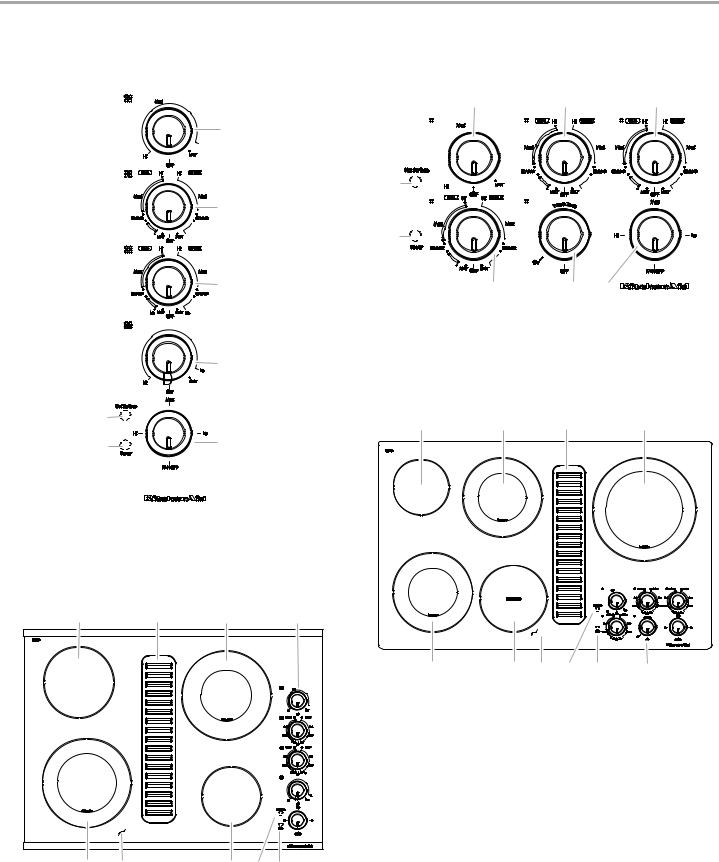
PARTS AND FEATURES
This manual covers different models. The cooktop you have purchased may have some or all of the items listed.
30" (76.2 cm) Control Panel |
|
36" (91.4 cm) Control Panel |
|
|
|
|
|
A |
|
B |
C |
|
A |
|
|
|
|
|
|
H |
|
|
|
|
B |
|
|
|
|
|
|
G |
|
|
|
|
C |
F |
|
E |
D |
|
|
|
|||
|
|
A. 6" (15.2 cm) Single element |
E. 6" (15.2 cm) Warming |
||
|
|
control knob |
|
element control knob |
|
|
|
B. 9"/6" (22.9 cm/15.2 cm) Dual |
F. 9"/6" (22.9 cm/15.2 cm) |
||
|
|
element control knob |
|
Dual element control knob |
|
|
D |
C. 12" (30.5 cm) Dual element |
G. “On” indicator light |
||
|
control knob |
|
H. Hot surface indicator light |
||
|
|
|
|||
|
|
D. Three speed fan control |
|
|
|
|
|
36" (76.2 cm) Cooktop Layout and Features |
|||
F |
|
A |
B |
C |
D |
|
|
||||
G |
E |
|
|
|
|
|
|
|
|
|
|
A.8" (20.3 cm) Single element control knob
B.9"/6" (22.9 cm/15.2 cm) Dual element control knob
C.9"/6" (22.9 cm/15.2 cm) Dual element control knob
D.6" (15.2 cm) Single element control knob
E. Three-speed fan control F. Hot surface indicator light
G.“On” indicator light
30" (76.2 cm) Cooktop Layout and Features
A B C D
JI
A.6" (15.2 cm) Single element
B.9"/6" (22.9 cm/15.2 cm) Dual element
C.Downdraft vent grille
D.12" (30.5 cm) Dual element
E.Control panel
H G F E
F. “On” indicator light
G.Hot surface indicator light
H.Ceramic cooking surface
I.Warming element
J.9"/6" (22.9 cm/15.2 cm) Dual element
I H
A.8" (20.3 cm) Element
B.Downdraft vent grille
C.9"/6" (22.9 cm/15.2 cm) Dual element
D.Control panel
G F E
E.“On” indicator light
F.Hot surface indicator light
G.6" (15.2 cm) Element
H.Ceramic cooking surface
I.9"/6" (22.9 cm/15.2 cm) Dual element
4
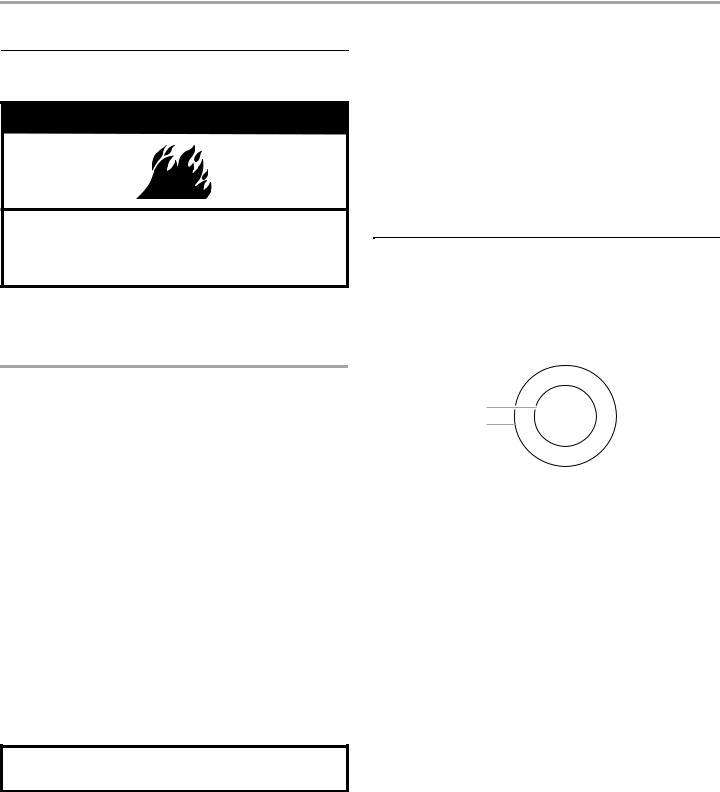
COOKTOP USE
CooktopControls
 WARNING
WARNING
Fire Hazard
Turn off all controls when done cooking.
Failure to do so can result in death or fire.
The controls can be set to anywhere between HIGH and LOW.
To Use:
Push in and turn knob to desired heat setting.
Use the following chart as a guide when setting heat levels.
SETTING |
RECOMMENDED USE |
|
|
|
|
High |
■ |
Bring liquid to a boil. |
|
|
|
Med High |
■ |
Hold a rapid boil. |
Medium High |
■ |
Quickly brown or sear food. |
|
||
|
|
|
Med |
■ |
Maintain a slow boil. |
Medium |
■ |
Fry or sauté foods. |
|
■ Cook soups, sauces and |
|
|
|
gravies. |
|
|
|
Med Low |
■ |
Stew or steam food. |
Medium Low |
■ |
Simmer. |
|
||
|
|
|
Low |
■ |
Keep cooked foods warm. |
|
|
|
Dual/Triple Circuit |
■ |
Home canning. |
Elements |
■ |
Large-diameter cookware. |
|
||
|
■ Large quantities of food. |
|
|
|
|
Melt |
■ |
Melt chocolate or butter. |
|
|
|
Warm Zone |
■ |
Keep cooked foods warm |
|
|
|
Hot Surface Indicator Light
This unit features a Hot Surface Indicator Light. The Hot Surface Indicator Light will glow as long as any surface cooking area is too hot to touch, even after the surface cooking area(s) is turned off.
If the cooktop is on when a power failure occurs, the Hot Surface Indicator Light will remain on after the power is restored to the cooktop. It will remain on until the cooktop has cooled completely.
Cooktop On Indicator Light
Each cooktop has a Cooktop On Indicator light. When the control knob is on, the light will glow.
Dual-CircuitElement
The dual-size element offers flexibility depending on the size of the cookware. Single size can be used in the same way as a regular element. The dual size combines single and dual elements, and is recommended for larger cookware, large quantities of food, and home canning.
Dual Element
A
B
A.Single element
B.Dual element
To Use SINGLE:
1.Push in and turn knob from the OFF position to the SINGLE zone anywhere between MELT and HIGH.
2.Turn knob to OFF when finished.
To Use DUAL:
1.Push in and turn knob from the OFF position to the DUAL zone anywhere between MELT and HIGH.
2.Turn knob to OFF when finished.
REMEMBER: When cooktop is in use, the entire cooktop area may become hot.
5
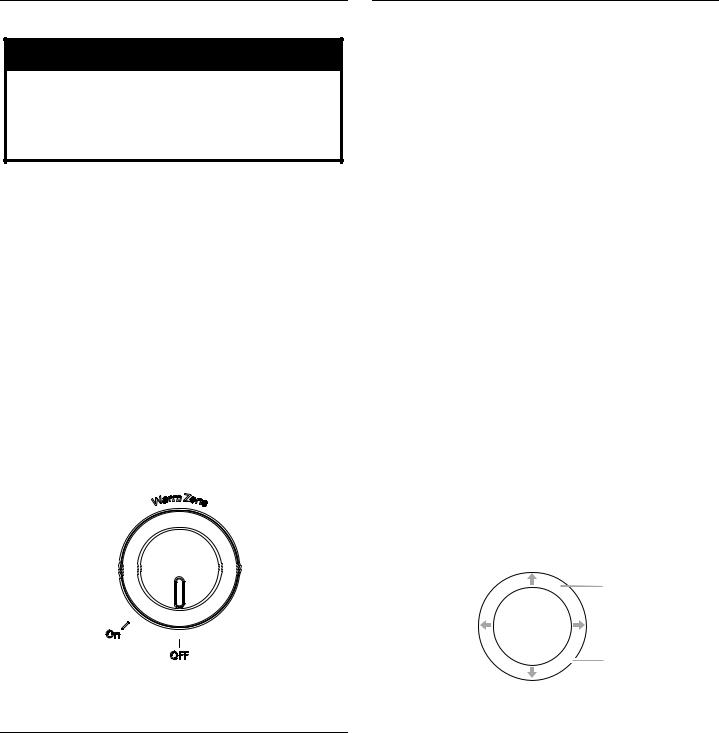
WarmZoneElement
 WARNING
WARNING
Food Poisoning Hazard
Do not let food sit for more than one hour before or after cooking.
Doing so can result in food poisoning or sickness.
The Warm Zone feature can be used to keep cooked foods warm. One hour is the recommended maximum time to maintain food quality.
Do not use it to heat cold foods.
When the Warm Zone feature is in use, it will not glow red like the cooking zones, but the indicator light will glow on the control panel.
The Warm Zone feature can be used alone or when any of the other surface cooking areas are being used, and can be set from LOW to HIGH for different levels of heating.
The Warm Zone Element area will not glow red when cycling on. However, the hot surface indicator light will glow as long as the Warm Zone Element area is too hot to touch.
■Use only cookware and dishes recommended for oven and cooktop use.
■Cover all foods with a lid or aluminum foil. When warming baked goods, allow a small opening in the cover for moisture to escape.
■Do not use plastic wrap to cover food. Plastic wrap may melt.
■Use pot holders or oven mitts to remove food.
To Use:
1.Push in and turn Warm Zone knob to desired setting.
2.Turn knob to OFF when finished.
Melt
The Melt function is available on all the surface cooking elements, and is ideal for melting chocolate or butter.
To Use:
1.Push in and turn knob to MELT.
2.Turn knob to OFF when finished.
CeramicGlass
The surface cooking area will glow red when an element is on, except when Melt or Warming Zone (on some models) are used. It may cycle on and off to maintain the selected heat level.
It is normal for the surface of light colored ceramic glass to appear to change color when surface cooking areas are hot. As the glass cools, it will return to its original color.
Cleaning off the cooktop before and after each use will help keep it free from stains and provide the most even heating. On cooktops with light colored ceramic glass, soils and stains may be more visible, and may require more cleaning and attention. Cooktop cleaner and a cooktop scraper are recommended. For more information, see “General Cleaning” section.
■Avoid storing jars or cans above the cooktop. Dropping a heavy or hard object onto the cooktop could crack the cooktop.
■To avoid damage to the cooktop, do not leave a hot lid on the cooktop. As the cooktop cools, air can become trapped between the lid and the cooktop, and the ceramic glass could break when the lid is removed.
■For foods containing sugar in any form, clean up all spills and soils as soon as possible. Allow the cooktop to cool down slightly. Then, while wearing oven mitts, remove the spills using a scraper while the surface is still warm. If sugary spills are allowed to cool down, they can adhere to the cooktop and can cause pitting and permanent marks.
■To avoid scratches, do not slide cookware or bakeware across the cooktop. Aluminum or copper bottoms and rough finishes on cookware or bakeware could leave scratches or marks on the cooktop.
■Do not cook popcorn in prepackaged aluminum containers on the cooktop. They could leave aluminum marks that cannot be removed completely.
■To avoid damage to the cooktop, do not allow objects that could melt, such as plastic or aluminum foil, to touch any part of the entire cooktop.
■To avoid damage to the cooktop, do not use the cooktop as a cutting board.
■Use cookware about the same size as the surface cooking area. Cookware should not extend more than ½" (1.3 cm) outside the area.
B
A
C
A.Surface cooking area
B.Cookware/canner
C.½" (1.3 cm) maximum overhang
■Use flat-bottomed cookware for best heat conduction and energy efficiency. Cookware with rounded, warped, ribbed or dented bottoms could cause uneven heating and poor cooking results.
■Determine flatness by placing the straight edge of a ruler across the bottom of the cookware. While you rotate the ruler, no space or light should be visible between it and the cookware.
■Make sure the bottoms of pots and pans are clean and dry before using them. Residue and water can leave deposits when heated.
■To avoid damage to the cooktop, do not cook foods directly on the cooktop.
6
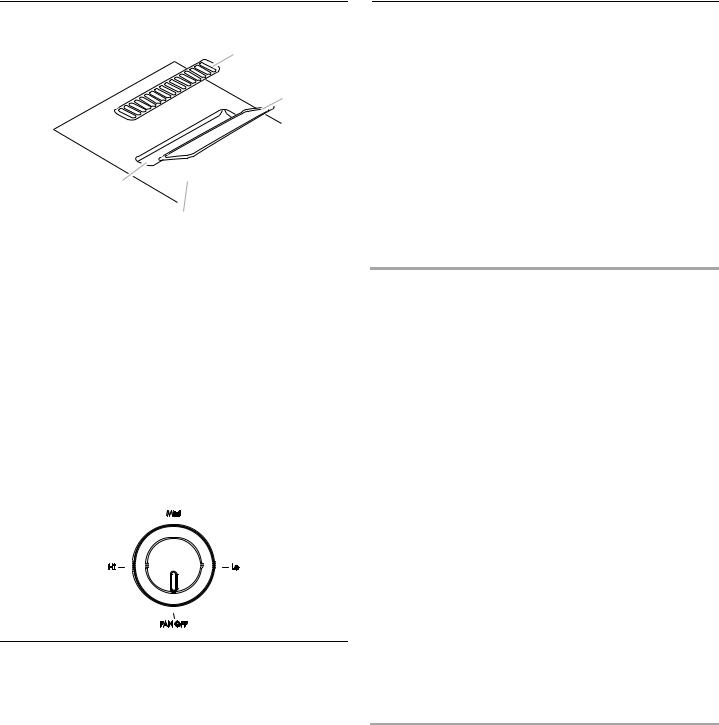
DowndraftVentilationSystem
A
C
B
D
A.Vent grille
B.Plenum chamber
C.Removable grease filter
D.Ceramic glass top
The downdraft ventilation system consists of a vent cover, filter and vent fan. The downdraft ventilation system removes cooking vapors, odors and smoke from foods prepared on the cooktop.
IMPORTANT: For optimal performance, operate downdraft ventilation system with the filter properly installed.
To avoid the buildup of grease, the filter should be cleaned often.
For more information on proper filter placement and cleaning, see “Downdraft Ventilation System” in the “General Cleaning” section.
To Use:
Turn vent fan knob to LOW, MED (medium) or HIGH. Turn vent fan knob to OFF when finished cooking, or when the cooktop is not in use.
HomeCanning
When canning for long periods, alternate the use of surface cooking areas, elements or surface burners between batches. This allows time for the most recently used areas to cool.
■Center the canner on the grate or largest surface cooking area or element. On electric cooktops, canners should not extend more than ½" (1.3 cm) beyond the surface cooking area or element.
■Do not place canner on 2 surface cooking areas, elements or surface burners at the same time.
■On ceramic glass models, use only flat-bottomed canners.
■For more information, contact your local agricultural department. Companies that manufacture home canning products can also offer assistance.
Cookware
IMPORTANT: Do not leave empty cookware on a hot surface cooking area, element or surface burner.
Ideal cookware should have a flat bottom, straight sides, and a well-fitting lid and the material should be of medium-to-heavy thickness.
Rough finishes may scratch the cooktop. Aluminum and copper may be used as a core or base in cookware. However, when used as a base they can leave permanent marks on the cooktop or grates.
Cookware material is a factor in how quickly and evenly heat is transferred, which affects cooking results. A nonstick finish has the same characteristics as its base material. For example, aluminum cookware with a nonstick finish will take on the properties of aluminum.
Use the following chart as a guide for cookware material characteristics.
COOKWARE |
CHARACTERISTICS |
|
|
|
|
Aluminum |
■ Heats quickly and evenly. |
|
|
■ Suitable for all types of cooking. |
|
|
■ Medium or heavy thickness is best for |
|
|
|
most cooking tasks. |
|
|
|
Cast iron |
■ Heats slowly and evenly. |
|
|
■ Good for browning and frying. |
|
|
■ Maintains heat for slow cooking. |
|
|
|
|
Ceramic or |
■ |
Follow manufacturer’s instructions. |
Ceramic glass |
■ Heats slowly, but unevenly. |
|
|
||
|
■ Ideal results on low to medium heat |
|
|
|
settings. |
|
|
|
Copper |
■ Heats very quickly and evenly. |
|
|
|
|
Earthenware |
■ |
Follow manufacturer’s instructions. |
|
■ Use on low heat settings. |
|
|
|
|
Porcelain |
■ See stainless steel or cast iron. |
|
enamel-on- |
|
|
steel or cast |
|
|
iron |
|
|
|
|
|
Stainless steel |
■ Heats quickly, but unevenly. |
|
|
■ A core or base of aluminum or copper |
|
on stainless steel provides even heating.
7
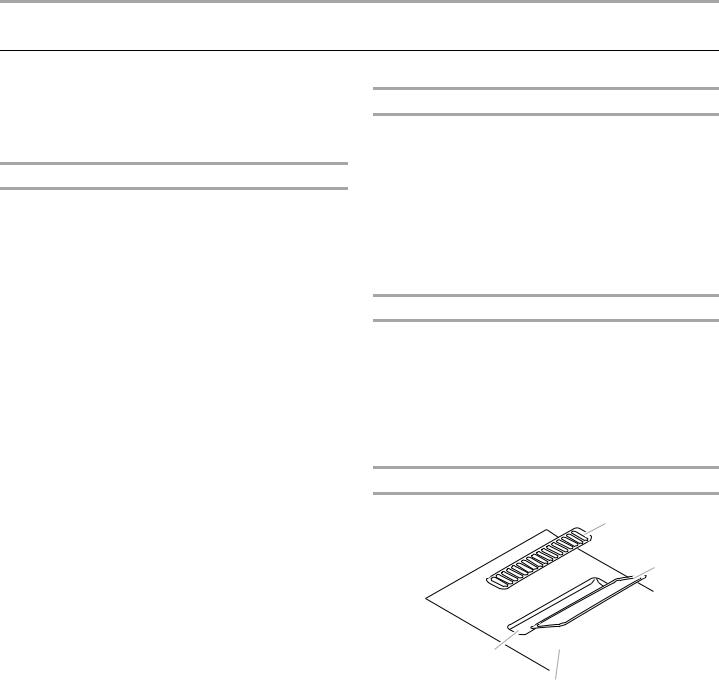
COOKTOP CARE
GeneralCleaning
IMPORTANT: Before cleaning, make sure all controls are off and the cooktop is cool. Always follow label instructions on cleaning products.
Soap, water and a soft cloth or sponge are suggested first unless otherwise noted.
CERAMIC GLASS
To avoid damage to ceramic glass, do not use steel wool, abrasive powder cleansers, chlorine bleach, rust remover or ammonia.
Always wipe with a clean, wet cloth or sponge and dry thoroughly to avoid streaking and staining.
Cooktop Polishing Creme is recommended for regular use to help avoid scratches, pitting and abrasions, and to condition the cooktop. It may be ordered as an accessory. See “Assistance or Service” to order.
A Cooktop Scraper is also recommended for stubborn soils, and can be ordered as an accessory. See “Assistance or Service” to order. The Cooktop Scraper uses razor blades. Store razor blades out of the reach of children.
Cleaning Method:
Light to moderate soil
■Paper towels or clean damp sponge
Sugary spills (jellies, candy, syrup)
■Cooktop Scraper:
Scrape sugary spills while the cooktop is still warm. You may want to wear oven mitts while doing so.
■Cooktop Polishing Creme and clean damp paper towel:
Clean as soon as cooktop has cooled down. Rub creme into surface with a damp paper towel or soft cloth. Continue rubbing until white film disappears.
Heavy soil, dark streaks, specks and discoloration
■Cooktop Polishing Creme or nonabrasive cleanser:
Rub product into soil with a damp paper towel or soft cloth. Continue rubbing until white film disappears.
Burned-on soil
■Cooktop Polishing Creme and Cooktop Scraper:
Rub creme into soil with damp paper towel. Hold scraper as flat as possible on surface and scrape. Repeat for stubborn spots. Polish entire cooktop with creme and paper towel.
Metal marks from aluminum and copper
■Cooktop Polishing Creme:
Clean as soon as cooktop has cooled down. Rub creme into surface with a damp paper towel or soft cloth. Continue rubbing until white film disappears. The marks will not totally disappear but after many cleanings become less noticeable.
Tiny scratches and abrasions
■Cooktop Polishing Creme:
Rub creme into surface with a damp paper towel or soft cloth. Continue rubbing until white film disappears. Scratches and abrasions do not affect cooking performance and after many cleanings become less noticeable.
COOKTOP CONTROLS
To avoid damage to the cooktop controls, do not use steel wool, abrasive cleansers or oven cleaner.
To avoid damage, do not soak knobs.
When replacing knobs, make sure knobs are in the Off position.
Do not remove seals under knobs.
Cleaning Method:
■Soap and water: Pull knobs straight away from control panel to remove.
■When replacing knobs, make sure they are in the OFF position.
STAINLESS STEEL (on some models)
To avoid damage to stainless steel surfaces, do not use soapfilled scouring pads, abrasive cleaners, Cooktop Cleaner, steelwool pads, gritty washcloths or abrasive paper towels.
Rub in direction of grain to avoid damaging.
Cleaning Method:
■Liquid detergent or all-purpose cleaner: Rinse with clean water and dry with soft, lint-free cloth.
■Vinegar for hard water spots.
DOWNDRAFT VENTILATION SYSTEM
A
C
B
D
A.Vent grille
B.Plenum chamber
C.Removable grease filter
D.Ceramic glass top
Vent Grille
Cleaning Method:
■Grasp the opening and lift the vent grille of the cooktop.
■Wipe clean or wash in sink:
Nonabrasive plastic scrubbing pad and mildly abrasive cleanser
■Dishwasher:
Use mild detergent.
8
